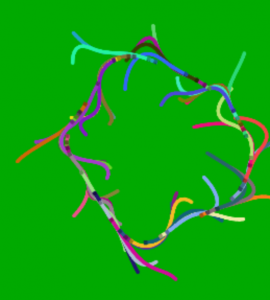
Original author
Resource type
Content area
Use type
Tools
Tags
Walk & Turn Activity, Demo of model, and CAST
Time needed: 30 - 45 minutes
Materials needed:
- Large open space
- Laptop(s) and projector, Walk & Turn model in StarLogo TNG
- White board and pens
- CAST sheets for students .
Running the activity
- Tell the students that in “Walk & Turn” each student will play the role of an “agent” following a “simple rule.” Ask students to form a circle standing at least 5 feet apart (You can also ask students “how would you go about forming a circle if you all started out bunched up in the center of the space?”).
- Next, explain the following rule: “Turn to face the person on your right while keeping this heading, take three steps.” Demonstrate how agents are supposed to keep the same heading rather than adjust the heading at each step.
- Have students try it once then ask for predictions about what will happen if they repeat the rule over and over again. (Use the term “iteration” as doing something over and over again.”
- Have students conduct the experiment and test their predictions in real-life.
- Have students come into the computer lab and together look at a computer model of the activity Walk & Turn. Using the computer model as a test-bed, students run experiments on the model by changing variables such as the number of agents.
- Ask “Does the same pattern emerge regardless of the settings of the variable?”
- Ask “Does this model and its outcome match what we experienced in real-life?” and “What are some similarities and differences between the model and what we did in real-life?
- Next we introduce the concept of randomly-distributed agents on the canvas (artificial landscape). Ask what the result of the simple rule would be if at the start the agents were scattered randomly rather than arranged in a circle. Again, make predictions then test those predictions against what the model produces.
- Finally, we go back outside and run the experiment in real-life using the “random” initial configuration. Does the real-life outcome match what the model generated? Why or why not?
- Ask “Did the outcome (the emergent pattern) match what happened the first time when students were in a circle?” and “Would we get the same pattern as an outcome if we scattered randomly again?”
- Explain that a system that adjusts to changes and produces similar patterns is called “adaptive” and that adaptivity is a characteristic of Complex Adaptive Systems.
- Review the new terms used in this activity: agent, simple rules, heading, iteration, prediction, emergent patterns, random, initial condition, outcome, phenomenon, and adaptive.
Concluding the activity:
Review the CAST at the board showing each circle and how zooming works.
- “At the individual scale… we see individuals”
- “At the local scale … we see interactions of individuals and/or the environment.”
- “At the global scale … we see emergent patterns, a view of whole system”
Using the CAST ask students what they see at the different scales in the Walk & Turn model. Have students answer and write notes on their individual CAST sheets labeled with “Walk & Turn”.
- At the individual scale… (individual turtles, with a location, a heading)
- At the local scale … (interaction between turtles consists of turning to face the turtle to your right, and taking steps in that direction while keeping the same heading.)
- At the global scale … (we see a spiral (emergent pattern), over time turtles get closer together and form a circle.)
Facilitator note:
What happens at the global scale (spiral pattern) was not predictable even though we knew the simple rules that agents were following at the local scale. This is a hallmark of a complex adaptive system.
Log in or register to view attachments and related links, and/or join the discussion
